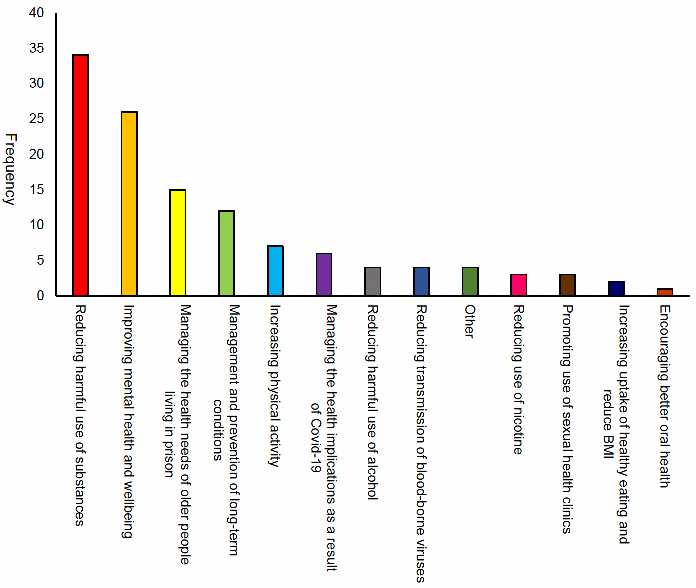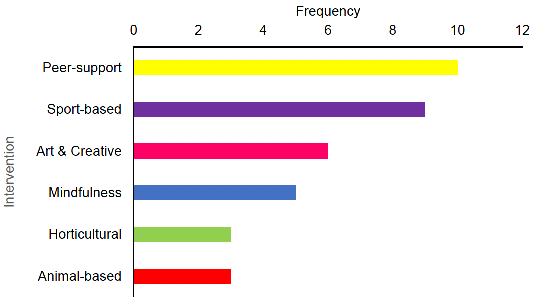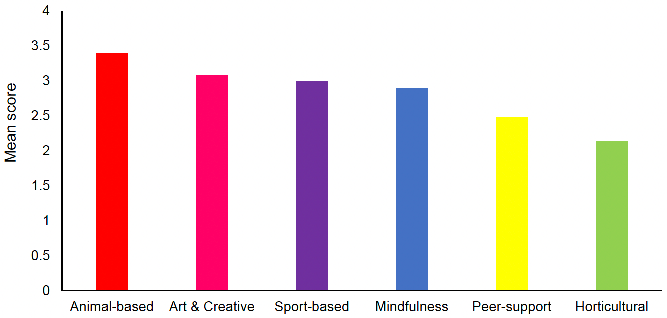Prison-based health and wellbeing interventions: evidence review and survey of provision
This study is a rapid review of the effectiveness of health and wellbeing interventions in prisons, and presents findings from a survey of Scotland's prisons on the extent to which these interventions are active.
4. Interventions in Scotland's Prisons – Survey Findings
An initial search of the literature identified a range of prison-based physical health and wellbeing interventions which are being used internationally and smaller amount in the UK. These fell in 6 categories: sport-based, horticultural, yoga, meditation, and mindfulness, art and creative, animal-based and peer-support. The researcher developed a survey to explore the extent to which these interventions are (or were, pre-Covid-19) being delivered in Scotland's prisons. It was developed in consultation with colleagues from the NPrCN, the SPS, and an external academic. The survey was distributed by the NPrCN using MS Forms on behalf of the Scottish Government to identified members of prison management and NHS staff.
The survey (see Annex D) collected information about what prison and NHS staff perceived to be the emerging or most pressing health needs of Scotland's prison population, the types of interventions delivered (or were pre-Covid-19) in Scotland's prisons, the uptake of those interventions by people who live in prison and the main facilitators and barriers to intervention delivery.
Open response questions were used to ask respondents if they were aware of any types of interventions currently being provided within their establishment outwith the categories already identified in the previous evidence review; interventions being offered in other prisons they think would be valuable within their establishment; and interventions being delivered in the community which could be modified and introduced to the prison environment.
A total of 12 of Scotland's 15 prisons (11 public and 1 private) had at least one respondent to the survey. A total of 37 responses were collected from prison management and NHS staff. Of the three prisons which did not respond to the survey, two housed adult males and one housed a mixed adult population.
Whilst this survey aimed to be robust as possible, time constraints restricted the length of time in which data could be collected and there were several considerations which had to be taken into account prior to and when analysing the data. Some of the prisons had a larger number of respondents compared to others. In particular, NHS responses were considerably higher compared to prison management responses. As such, the researcher controlled for multiple responses where necessary (i.e., responses were grouped by prison and role to identify if interventions were delivered in establishments).
A number of differences emerged in the data such as differences between prison management and NHS staff as to whether or not an intervention category was provided in their establishment. These tensions point to different approaches and engagement with various health interventions across the Scottish prison estate. In addition, some prisons had responses from NHS staff only and it was taken into account that this group may not be fully aware of all of the interventions asked about in this survey, as it is expected that a high proportion of these may be delivered with no health centre involvement. Consequently, the findings of this survey should be viewed as indicative rather than complete.
4.1 Health needs of Scotland's prison population
Respondents were first asked "What do you see as the three emerging health needs of the population in your establishment/healthcare centre?" The results found that reducing harmful use of substances, improving mental health and wellbeing and managing the health needs of the ageing population in prison were the three emergent health needs reported for Scotland's prison population. This has been shown in Figure 2 provided below.

Reducing the harmful use of substances and improving mental health and wellbeing showed a dominance when compared to the other health needs. Given that the sample included prison management and NHS staff, this suggests that staff with different responsibilities and who work across the prison setting are both observing these two health needs most prominently in people who live in Scotland's prisons.
4.2 Interventions in Scotland's Prisons
A key aim of the survey was to identify which physical health and wellbeing interventions are currently active (or were pre-Covid-19) in Scotland's prisons. Respondents were therefore asked "What physical health and wellbeing interventions are currently being provided in your establishment/healthcare centre?". Animal-based, art and creative, horticultural, mindfulness, peer-support and sports-based interventions are being delivered across Scotland's prisons to varying degrees (see Figure 3).

The interventions which were delivered across the majority of the prisons were peer-support (n=10) and sport-based (n=9). In addition, half of the prisons reported the use of art and creative interventions (n=6). Mindfulness (n = 5), horticultural (n = 3) and animal-based (n=3) interventions were less common across Scotland's prisons. Given that improving mental health and wellbeing was a key health need identified in the survey, it is encouraging to see interventions which are designed to fulfil this need are active in Scotland's prisons.
Respondents were additionally asked "Are there any types of physical health and wellbeing interventions missing from the above list that are being provided within your establishment/healthcare centre?" A total of 11 respondents answered yes and provided details. Examples of the types of other interventions being offered in Scotland's prisons included some which can be classified under the current intervention categories but provide additional detail about the nature of interventions being provided in Scotland's prisons. Examples included:
- Sport: "outside personal training exercise groups", "dance" and "general use of the gym"
- Art and creative: "music" and "radio shows"
- Horticultural: "therapeutic garden design"
- Other: "in cell activities including crochet, mental health packs…" "hair and beauty" and "mental health awareness"
4.3 Uptake of interventions in Scotland's Prisons
Respondents were asked to assess the uptake of the interventions by those who live in their establishment. They were asked "How would you rate the uptake of these physical health and wellbeing interventions in your establishment/healthcare centre? If the establishment/healthcare centre does not provide an intervention listed, please select N/A". A 4-point Likert scale was used (1 = poor[11] to 4 = excellent) and a mean score calculated to assess the uptake of each of the identified categories of physical health and wellbeing interventions being delivered in Scotland's prisons. For the majority of interventions, the uptake was encouraging (see Figure 4).

Across the prisons which have introduced animal-based interventions, the uptake was very good in prisons which house young male and female prison populations (M = 3.4, SD = 0.84). It was identified that one prison's uptake score for animal-based intervention was lower in comparison to the others.
The uptake of art and creative interventions was good overall (M = 3.08, SD = 0.85). This was consistent across both male and female (adult and young) prison populations. The main difference in uptake scores was between NHS and prison management with the latter rating the uptake of these interventions more positively.
Mindfulness intervention uptake varied across prisons (M = 2.89, SD = 0.78). Uptake was rated more positively across adult male and mixed adult prison populations compared to prisons which house young offenders and open prison estates.
Horticultural interventions are currently offered in a small number of prisons in Scotland (n=3), with the uptake of them being the lowest of all of the intervention categories (M=2.13, SD = 1.13). It was identified that there was disparity across prisons, with uptake highest in an adult male prison.
For peer-support interventions uptake was adequate (M = 2.48, SD = 0.92). The majority of prisons reported adequate or good uptake. However, uptake was found to be lower in prisons which house young and adult male prison populations.
Sport intervention uptake across Scotland's prisons was good (M = 3.00, SD = 0.49). The majority of prisons reported good or excellent uptake.
4.4 Facilitators and barriers to intervention delivery
An area which might extend our understanding of physical health and wellbeing intervention provision in Scotland's prisons was to identity what prison and NHS staff view as facilitators and barriers to intervention delivery. Respondents were asked "What are the facilitators that best support the delivery of these physical health and wellbeing interventions?" and "What are the main barriers that prevent the delivery of physical health and wellbeing interventions?"
The following facilitators were identified by respondents:
- Staffing (75.7%)
- Physical resources (64.9%)
- Participant engagement (56.8%)
- A supportive partnership agreement with a third sector organisation (54.1%)
- A positive relationship between participants and those delivering the intervention (51.4%)
The following barriers were identified by respondents:
- Staffing (75.7%)
- Scheduling (54.1%)
- Physical resources (45.9%)
- Difficulty engaging participants (40.5%)
- Funding (40.5%)
It was recognised that staffing, physical resources and engagement with interventions were identified as both facilitators and barriers. Physical resources were largely seen as a facilitator across the prisons with the exception of three, which were either large capacity prisons and/or were recommended for refurbishment in independent reports. It was also found that across some prisons, NHS staff viewed physical resources as a barrier to intervention delivery, whereas prison management in the same prison viewed physical resources as a facilitator. In regard to staffing and engagement with interventions, many respondents identified this as both a facilitator and barrier within their establishment, which suggests there may be differences across the interventions provided.
4.5 Interventions staff wish to see introduced in their establishment
Respondents were asked "Are there any physical health and wellbeing interventions within other establishments/healthcare centres that you know of that could be valuable within your establishment/healthcare centre?" Approximately 25% of respondents were aware of physical health and wellbeing interventions in other prisons which they felt would be valuable within the establishment they currently worked in. One intervention, in particular, which was identified across responses was the introduction of animal-based interventions, for example "Paws for Progress" and the "keeping of bees/chickens". Other interventions respondents wished to see introduced included "walking groups", "rugby", "football leagues", "allotment/gardening", "yoga", "mindfulness" and "communication based groups".
In addition, respondents were asked "Are you aware of any health and wellbeing interventions in the community that you think could be introduced into your establishment/healthcare centre?". Approximately 30% of respondents felt there were interventions being delivered in the community which they would like to see modified and/or introduced in the establishment they worked in. Among the open-text responses were the following suggestions "nature walks", "recovery cafes", "educational packages relating to health, wellbeing and addictions", "touch rugby", "local football leagues", "equine therapy", "drama therapy" and "storybook dads".
Contact
Email: social.research@gov.scot
There is a problem
Thanks for your feedback